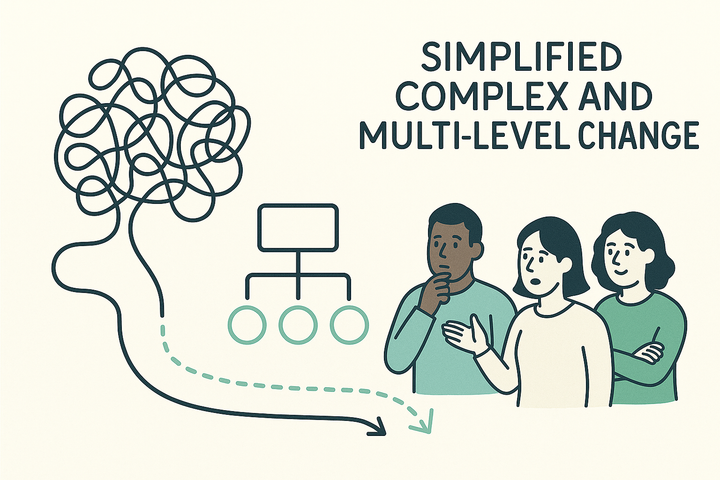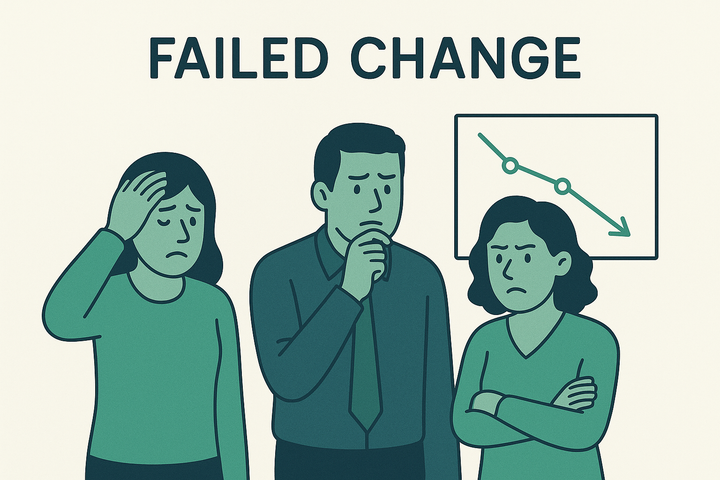Creating Feedback Loops in Complex Change
In change, feedback isn’t engagement theatre. It’s strategic intelligence. Here’s how to build feedback loops that let you lead through complexity — and why they matter more than ever.

Feedback isn’t just a form
Too many organisations reduce feedback to a survey.
A quarterly pulse. A comment box. A “have your say” email that doesn’t go anywhere.
But in complex change — the kind that shifts how people work, how power flows, or what a job even is — feedback can’t be an accessory. It has to be an operating system.
Because change doesn’t unfold cleanly. People don’t behave predictably. And if you’re not listening carefully at every level, you’ll miss the signals you most need to hear.
Why feedback loops matter in complex change
Here’s the truth: most change plans don’t survive contact with the organisation.
You overestimate readiness. You underestimate concern. You get one word wrong in your messaging and spend three weeks recovering trust.
Feedback isn’t just a good idea. It’s how you stay in motion.
Without real-time feedback loops, you can’t:
- Know whether your message is landing or leaking
- See early signs of fear, resistance or misunderstanding
- Track how different teams and leaders are interpreting the narrative
- Course-correct before momentum drops
- Spot the slow erosion of belief, energy or alignment
In complexity, sensemaking beats certainty.
And feedback is how you make sense — early, often and with humility.
Feedback is more than employee engagement
This is where most organisations get stuck. They treat feedback as a staff-only function — something for “engagement” to handle, while the comms team pushes out the message, and leaders stay insulated.
But a strong feedback loop isn’t just about inclusion. It’s about strategic intelligence.
You need feedback from:
- Employees: What are they hearing? What are they worried about? What’s being said in the gaps between meetings?
- Managers: What questions are coming up again and again? What’s proving hard to land? Where are they feeling stuck or unsupported?
- Senior leaders: Are they aligned in their messaging? Are they role-modelling the change? Or quietly resisting it?
If you’re only listening at one level, you’re not getting the full signal. You’re getting fragments — and guessing the rest.
Why it matters more than ever: AI, automation and the shape of what’s coming
Feedback loops are about to become critical infrastructure in every organisation, especially as AI reshapes the way we work.
We’re not just talking about new tools or clever integrations. We’re talking about:
- Whole roles are being redefined
- Power shifting between departments
- Trust is being tested by opacity and speed
- Ethics, efficiency and existential questions sitting side by side
And let’s be honest: most employees are not being brought into these conversations early. They’re experiencing the shift as something happening to them, not with them.
That’s dangerous.
Because if you don’t know what your people are worried about, confused by, or quietly testing out, you can’t lead them through what’s coming.
If you want to keep work human in an AI-shaped future, feedback loops are your compass. They help you:
- Hear real fears before they harden
- Track how language and culture are adapting
- Stay emotionally connected while strategically evolving
- Translate the noise (sound) into insight (signal)
In short: they help you sense before you steer.
How to build strong, useful feedback loops
- Make them layered
Don’t just ask staff. Ask managers. Ask leaders. You’ll get different truths — and you need all of them. - Make them rhythmic
One survey a year won’t cut it. Build feedback into every phase of delivery. Make it part of the change rhythm. - Make them safe
People won’t share real concerns if the stakes are too high. Anonymity matters. So does psychological safety. - Make them visible
Show what changed because of what you heard. People will only keep contributing if they see it’s worth it. - Make them useful
Don’t just log data. Analyse patterns. Compare across roles, teams, and moments. Use it to drive decisions. - Make them flexible
If a channel isn’t working, drop it. If a team needs a different method, try it. Rigid systems miss real signals.
What this unlocks
Done right, feedback loops help you:
- Adapt messaging in real time
- Re-align leadership without waiting for crises
- Spot unseen risks before they blow up
- Keep employees emotionally connected even as tasks shift
- Embed a culture of openness in how you change, not just what you change
They become a living dashboard — not of metrics, but of meaning.
Final thought
Most change fails not because the plan was bad — but because no one checked whether it was still working.
Feedback isn’t soft. It’s structural.
If you want to lead in complexity — and bring people with you through change, disruption and everything AI is about to throw at us — don’t wait until after the fact.
Listen now. Adjust now. Learn as you go.
Because if you want a signal, you need a system to hear it.
Want to build a feedback system that actually works?
Start with the Sound & Signal Review — our no-fluff diagnostic that shows where your narrative is missing the mark, how people are reacting, and what you need to do differently.
Or, if change is already rolling and feedback is thin, the Rapid Action Accelerator can help you build immediate listening loops and translate that into real-time adjustments — fast.
Would you like me to create the illustration for this one now?



